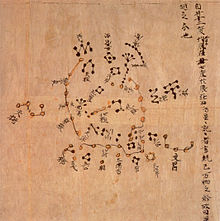List of ancient Chinese calendars

The Chinese calendar is an astronomical lunisolar calendar . It describes astronomical events such as eclipses, etc. Over the centuries, improvements have been made again and again or the basis for calculations was lost in the course of disputes between the Chinese states. This led to a whole series of calendars, e.g. T. were in use at the same time.
| Calendar name | author | Year of creation | Year of introduction | dynasty | Solar year | Lunar year |
|---|---|---|---|---|---|---|
| Huangdi, Xia, Yin Zhou, Lu | Unknown | Unknown | Unknown | Unknown | 365.25 | 29.53085 |
| Zhuanxu | Unknown | Unknown | 221 (?) - 105 BC Chr. | Qin Dynasty , Han Dynasty | 365.25 | 29.53085 |
| Taichu | Deng, Ping, etc. a. | 104 BC Chr. | 104 BC Chr. -85 AD | Han dynasty | 365.2502 | 29.53086 |
| Soaps | Li Fan, Zhang Heng | 85 | 85-263 | Han dynasty , Shu-Han | 365.25 | 29.53085 |
| Qianxiang | Liu Hong | 206 | 223-280 | Wu dynasty | 365.2462 | 29.53054 |
| Jingchu | Yang Wei | 237 | 237-451 | Wei Dynasty , Jin Dynasty , Song Dynasty , Northern Wei | 365.2469 | 29.53060 |
| Sanji | Jiang Ji | 384 | 384-417 | Later Qin | 365.2468 | 29.53060 |
| Yuanshi | Zhao Fei | 412 | 412-439, 452-522 | Northern Liang , Northern Wei | 365.2443 | 29.53060 |
| Yuanjia | Hey Chengtian | 443 | 445-509 | Song , Southern Qi Dynasty , Liang Dynasty | 365.2467 | 29.53059 |
| Daming | To Chongzhi | 462 | 510-589 | Liang Dynasty , Chen Dynasty | 365.2428 | 29.53059 |
| Zhengguang | Zhang Longxiang | 521 | 523-565 | Northern Wei , Northern Zhou | 365.2437 | 29.53059 |
| Xinghe | Li Yexing | 540 | 540-550 | Eastern Wei | 365.2442 | 29.53060 |
| Tianbo | Song Jingye | 550 | 551-577 | Northern Qi | 365.2446 | 29.53060 |
| Tianhe | Jian Luan | 566 | 566-578 | Northern Zhou | 365.2443 | 29.53071 |
| Daxing | Ma Xian | 579 | 579-583 | Northern Zhou , Sui Dynasty | 365.2438 | 29.53063 |
| Kaihuang | Zhang Bin | 584 | 584-596 | Sui dynasty | 365.2434 | 29.53061 |
| Daye | Zhang Zhouxuan | 597 | 597-618 | Sui dynasty | 365.2430 | 29.43059 |
| Wuyin Yuan | Fu Renjun | 619 | 619-664 | Tang Dynasty | 365.2446 | 29.53060 |
| Linden tree | Li Chungfeng | 665 | 665-728 | Tang Dynasty | 365.2448 | 29.53060 |
| Dayan | Yi Xing | 728 | 729-761 | Tang Dynasty | 365.2444 | 29.53059 |
After this time, Indian, Persian and European ideas came and changed the approach of astronomers. Shen Kuo developed the 12 Qijie calendar during the Song Dynasty (960-1127). Persian insights induced Guo Shoujing (1231–1316) to develop the Shoushi calendar (also: Shou shih li (授 時 曆)). It was introduced in 1280 at the beginning of the Yuan Dynasty (1279-1368). It was valid for a long time. Jesuits came to China during the Ming Dynasty (1368–1644). So it came about that during the early Qing Dynasty (1644–1911) the German missionary Johann Adam Schall von Bell created the Shixian calendar . It was the official calendar until the Minguo calendar was introduced in 1912 . This is still used in the Republic of China (Taiwan) today, while mainland China has used the Gregorian calendar since the People's Republic of China was founded in 1949 . What is known today as the Chinese calendar is the Shixian calendar .
Web links
- The calendar reform of 462 (eng.) (PDF file; 1.24 MB)
- History of Chinese Calendar ( Memento from July 31, 2008 in the Internet Archive )
